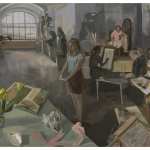
Contributed by Sharon Butler / In the New York art community of the early 1900s, Marsden Hartley (born Lewiston, Maine 1877; died 1943 Ellsworth, Maine) found success elusive, and discovered, as almost all artists do, that developing a unique voice was a challenging proposition. He worked in New York, spent several years traveling to Europe, New Mexico, and Nova Scotia (solo exhibitions have been mounted for each of these periods), and then, at the urging of his New York dealer Alfred Stieglitz, eventually returned to his home state of Maine, where he had lived until he was twelve and would spend the last six years of his life. In forsaking the art community and an urban milieu — which had certainly yielded some fine work, if not commensurate recognition — for a rootsy regionalism, he hoped to develop a distinctive version of American Modernism. And so he did. Hartley’s paintings, on view in “Marsden Hartley’s Maine” at The Met Breuer, reveal a solitary yet ambitious artist deeply engaged in the painting life and committed to exploring the essence of America.





As generous text on the show’s wall panels reveals, considerable career calculation went into Hartley’s return to his home state. He embraced the hardship of wilderness, undertaking at age 60 a four-mile trek by foot to Mount Katahdin — which for him, like Cezanne’s Mont Sainte-Victoire, became singularly iconic — in heavy rain. He strategically declared himself “the painter of Maine,” but Hartley’s influences were clear. He drew freely and openly from Paul Cezanne, the Impressionists (particularly the broken brushstrokes), Japanese printmakers Utagawa Hiroshige and Katsushika Hokusai, Winslow Homer, and Albert Pinkham Ryder, all of whose work from the Met’s collection is included in the exhibition. Cezanne, Hiroshige, and Hokusai’s preoccupation with mountains in the landscape, Homer’s fixation on Maine’s rocky coast, and Ryder’s evocative depictions of clouds as objects are all manifest in Hartley’s Maine paintings.




Alongside Hartley’s careful calibrations, there is also some notable candor. In more cryptic, abstract paintings than the ones painted in Maine, he had memorialized the young Prussian lieutenant Karl von Freyburg in Germany, with whom he was in love and who would die in World War I. His Maine figurative paintings and drawings depict brawny loggers and men in swimsuits, reflecting what to a contemporary eye is clearly homoeroticism, though apparently it was not construed as such when Hartley made the paintings. Taken in biographical context, the Maine paintings indicate a forlorn, insular dimension of Hartley’s personality. The sense of loneliness in the Maine paintings is palpable.

Hartley was an artistic survivor, and, as this remarkable show proves, a resourceful and ambitious one. Could “Marsden Hartley’s Maine” constitute a general recommendation for young artists to return to their geographic roots? Perhaps so. It certainly worked for Hartley.
“Marsden Hartley’s Maine,” co-curated by Randall Griffey, Elizabeth Finch, and Donna M. Cassidy.The Met Breuer, UES, New York, NY. Through June 18th, 2017. Co-organized with the Colby College Museum of Art, where the exhibition will be featured from July 8 through November 12, 2017.
Related Posts:
Gregory Amenoff’s studies
Snaps: A visit to Maine College of Art
A studio visit with Sascha Braunig














“Hartley’s his influences were clear”
Dear author(s) I think you want to remove the “his” in the above from your piece.
Happy to leave a comment. Hrag over at Hyperallergic exercised his dark dictatorial power and removed me from commenting at that site. He is as fond of promoting protests that he agrees with as he is fond of wiping out dissent that he disagrees with. Don’t look to him to defend first amendment rights.
Still awaiting moderation?
From email:
Hi Sharon,
Just a quick note to say how much I Ioved reading your recent piece on Harley�s ambitions and influences. Thank you!
Because of my own fascination with ice (in all its forms), and my family connection to the ice harvesting industry, I was especially delighted to finally see the Marsden Hartley Ice Hole, Maine (1908) recently at the wonderful Met/Breuer exhibition. In this early painting, I noticed Hartley had embedded his monogram of �MH” in his painted landscape. I haven�t had chance to read the curators�s essays yet, and I�m guessing they also comment on this early, bold personal claim Hartley in making on the Maine landscape. Some twenty years later he asserts publicly his desire to the be the “painter of Maine.� The New Orleans painting demonstrates he had this ambition on his mind much earlier when he formed the M of the mountain and the H of the ice hole effectively making a self-portrait of the landscape! Michael Taylor (formerly at the Hood now at Virginia MFA) had alerted me to this work several years ago during a studio visit in VT to view my series of �Ice Cut� paintings. And ever since, this early painting of Hartley has really stuck with me. I�m going to try to find out how it ended up in New Orleans�a key 19th and early 20th century port for the shipment of ice from Maine to the Carribean and South America� There must be a crazy story to that provenance!
Thank you again for your wonderful and necessary coverage in �Two Coats of Paint!�
Best wishes for the spring.
–Eric Aho
ripper, sea at night at Peabody Essex
wild man
thx